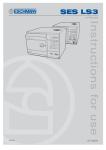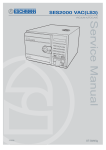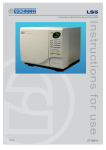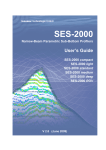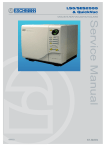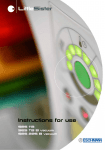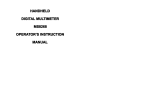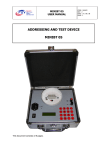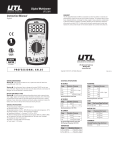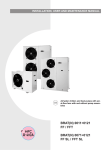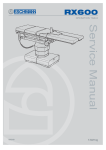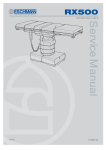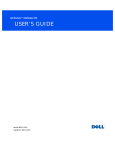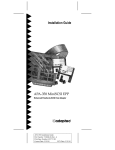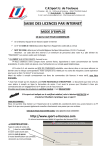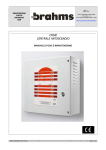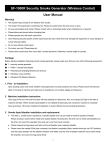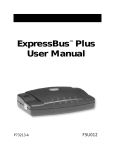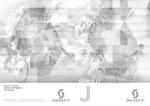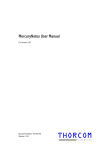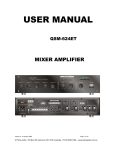Download - Frank`s Hospital Workshop
Transcript
SES2000
A UT O CLAVE
Service Manual
699215
ST-SM8l
Read these Instructions before use
Introduction
Description
Maintenance
Illustrated parts list
Keep these instructions in a safe convenient place for future reference. Read in conjunction
with the Publications detailed in Section 1.5.
This Service Manual applies to the following Autoclave REF numbers. (Note: In the parts list
section reference is also made to parts required for earlier versions) :SES 2000 STANDARD (from Serial Number - SCB8B0000, or SED8B0000 for non-CE)
without printer : 87-028-04 87-028-20 87-028-36 87-029-05 87-029-13 87-029-21
87-029-37 87-029-45 87-029-54 87-029-62 87-029-70 87-029-78
87-029-86 87-030-03 87-030-11 87-030-27 87-030-43 87-030-60
87-031-03 87-031-68
with printer :
87-028-12
87-031-76
87-028-28
87-028-44
87-029-26
87-030-65
87-031-11
SES 2000 LONG (from Serial Number - LSCB8B0000, or LSED8B0000 for non-CE)
without printer : 87-028-53 87-028-69 87-028-85 87-028-90 87-028-97 87-029-29
87-029-94 87-030-70 87-031-19 87-031-84 87-020-05 87-022-01
87-022-17 87-020-21 87-022-49 87-022-66
with printer :
87-028-61
87-022-09
87-028-77
87-022-25
87-030-75
87-020-29
87-031-27
87-022-58
87-031-92
87-022-74
87-020-13
(Note: The alpha parts of the SN are significant.)
Service Manual
Eschmann After Sales Service Department
The Eschmann After Sales Service Department is staffed and equipped to provide advice and
assistance during normal office hours. To avoid delays when making enquires, please quote the
Model and Serial Number of your Autoclave. Please ensure you include all alpha and numeric
digits of the Serial Number. (NOTE: The Serial Number Plate is located inside the door in the top
left hand corner).
For further information visit www.eschmann.co.uk
All correspondence relating to the after sales service of Eschmann Equipment to be addressed to :
UK Customers
Eschmann Equipment, Peter Road, Lancing, West Sussex BN15 8TJ, England.
Tel: +44 (0) 1903 765040. Fax: +44 (0) 1903 875711.
Overseas Customers
Contact your local distributor. In case of doubt contact Eschmann Equipment.
Patents and Trade marks
The ESCHMANN name and logo are trade marks of Eschmann Holdings Limited.
“Eschmann Equipment” is a trading name of Eschmann Holdings Limited.
“SES2000” is a trade mark of Eschmann Holdings Limited.
Patents : Patents Pending plus - Pat. US5090033 and Pat. GB2238407
Copyright © 2008 Eschmann Holdings Limited
All rights reserved. This booklet is protected by copyright. No part of it may be reproduced, stored in a
retrieval system or transmitted in any form or by any means, electronic, mechanical, photocopying,
recording or otherwise without written permission from Eschmann Holdings Limited.
The information in this publication was correct at the time of going to print. The Company, however,
reserves the right to modify or improve the equipment referred to.
The CE marking affixed to the product certifies that it complies with the
European Medical Devices Directive 93/42/EEC and related legislation.
ST-SM8l November 2008
SES 2000 AUTOCLAVE
CONTENTS
Page
Contents .. ..
Technical data ..
..
..
..
..
..
..
..
..
..
..
..
..
3
4
..
..
..
..
..
..
6
6
6
..
..
..
..
..
..
..
..
..
..
..
..
..
..
..
..
7
7
9
9
10
11
11
11
..
..
..
..
..
..
..
..
..
..
..
..
..
..
..
..
..
..
..
..
..
..
..
..
..
..
..
..
..
..
..
..
..
..
..
..
..
..
..
..
..
..
..
..
..
..
..
..
..
..
..
..
..
..
..
..
..
..
..
..
..
..
15
15
20
20
20
20
20
20
20
21
21
22
22
22
22
22
23
23
23
23
23
23
23
24
24
24
24
24
25
25
25
PART 1 INTRODUCTION
General .. ..
.. ..
Associated publication ..
Servicing .. ..
.. ..
..
..
..
..
..
..
PART 2 DESCRIPTION
General .. ..
Operating features
Operation cycle
Operation ..
Display messages
Error indication
General
..
Overheating
..
..
..
..
..
..
..
..
..
..
..
..
..
..
..
..
..
..
..
..
..
..
..
..
..
..
..
..
..
..
..
..
PART 3 MAINTENANCE
Fuses
.. ..
.. .. ..
..
Fault diagnosis and table
..
..
Parts replacement and adjustment
Removing cover .. .. ..
..
Refitting cover .. .. ..
..
Thermal fuse
.. .. ..
..
Transformer..
.. .. ..
..
Controller board .. .. ..
..
Pressure door lock .. ..
..
Air valve
..
.. .. ..
..
Door interlock switch .. ..
..
Solenoid door lock (CE only) ..
Heater cycling thermostat ..
..
Temperature sensors .. ..
..
Fill and Discharge valves ..
..
Solid state relay (Non-CE)
..
Solid state relay (CE only)
..
Mechanical relay (CE only)
..
Heating element .. .. ..
..
Printer interface board
..
..
Voltage regulators
.. ..
..
Door seal ..
.. .. ..
..
Pressure gauge .. .. ..
..
Discharge line filter .. ..
..
Printer
..
.. .. ..
..
Special operating modes
..
..
Demonstration mode .. ..
..
Engineering mode .. ..
..
Set-up mode
.. .. ..
..
Switch identities and function ..
Power-on modes
.. ..
..
ST-SM8l
Page
Set-up procedure
.. ..
.. .. .. 26
Autoclave without printer .. .. .. 26
Autoclave with printer ..
.. .. .. 26
Setting the Autoclave Serial Number 26
Entering the Autoclave Serial Number 27
Entering the date and time .. .. .. 27
Errors and error clearing
..
.. .. .. 28
General
.. .. .. ..
.. .. .. 28
Control sensor selection ..
.. .. .. 28
Autocheck .. .. .. ..
.. .. .. 28
Routine Autoclave Calibration
.. .. .. 28
General
.. .. .. ..
.. .. .. 28
Calibration procedure
..
.. .. .. 29
Safety valve .. .. .. ..
.. .. .. 29
Operational test .. .. ..
.. .. .. 30
PART 4 ILLUSTRATED PARTS LISTS
Pipes and fittings, latest models .. ..
Illustrated parts list 1: Pipes and valves
Illustrated parts list 2: General spares
Illustrated parts list 3:
Heater and process controls ..
.. ..
.. 30
.. 31
.. 33
.. 35
ILLUSTRATIONS
Fig. 1 SES 2000 Autoclave ..
.. .. ..
Fig. 2 Autoclave General Arrangement ..
Fig. 3 Autoclave: Pipes and Valves .. ..
Fig. 4 Autoclave: Heater & Process Controls
Fig. 5 Door interlock microswitch
.. ..
Fig. 6 Filter unit disassembly
.. .. ..
Fig. 7 Switch identities and function .. ..
Fig. 8 Autoclave Controller boards .. ..
Fig. 9 Pipes and valves
..
.. .. ..
Fig. 10 General spares .. ..
.. .. ..
Fig. 11 Heater and process controls .. ..
Fig. A1-A5 Autoclave printer details .. ..
6
12
13
14
21
24
25
30
32
34
36
40
TABLE
Fault Diagnosis table
..
..
..
..
.. 15
..
..
.. 39
..
..
.. 41
..
..
.. 42
APPENDIX A
Autoclave printer
..
..
..
APPENDIX B
Schematic - Pipes and Valves
APPENDIX C
Schematic - Wiring
..
..
Page 3 of 43
SES 2000 AUTOCLAVE
TECHNICAL DATA
(Standard Version)
Dimensions
Electrical Data
Supply
220/230/240V a.c. at 50/60Hz
110V a.c. at 50/60Hz
Nominal Loading @ 230V - 2kW (8.7A)
@ 110V - 1.4kW (12.7A)
Fuses
Chassis
230/240V 10A, Part No.380003, (x2)
400mA, Part No.696181, (x1)
220V
13A, Part No.380002, (x2)
400mA, Part No.696181, (x1)
110V
16A, Part No.111940, (x2)
800mA, Part No.380004, (x1)
Relay board
T2A, 250V (x1)
Safety standards
Width
Length
Height
460mm
461mm
360mm
Chamber
Diameter
Length
Capacity
200mm
348mm (max)
10.6 litres
Trays
Width
Length
Height
183mm
282.6mm
l7mm
Tray Loading
1.5 kg per tray
Weight (approx.)
Net
Shipping
27.5kg
32.0kg
Symbols
IEC 1010-1:1990
IEC 601-1:1977
BS5724:Part 1:1979
ESCHLE (Second Edition 1986)
IEC 601-1-2 (1993)
Sterilizing Data
Sterilizing time
At 134/137°C
At 121/124°C
Autoclave
For use with alternating current
Caution Hot Surface
Caution refer to accompanying
documents
3 mins 20 sec.
15 mins
Typical overall cycle
time (D indicates
drying included)
134°C : 13 minutes
134°C : 30 minutes (D)
121°C : 24 minutes
121°C : 41 minutes (D)
Note: Overall cycle times may vary depending
on machine and loading conditions.
Sterilising cycle without drying phase
(NB. temperature = cycle temperature)
Sterilising cycle with drying phase
(NB. temperature = cycle temperature)
Nominal Operating pressures:
134°C cycle - 3.14 bar abs
121°C cycle - 2.11 bar abs
Water reservoir
capacity
Page 4 of 43
2.0 litres
ST-SM8l
SES 2000 AUTOCLAVE
TECHNICAL DATA
(Long Version)
Dimensions
Electrical Data
Supply
230Vac at 50/60Hz
Nominal Loading
@ 230V - 2.75kW (12A)
Fuses
Chassis
15A, 250V, (x2) Part No. 301871
400mA, Part No. 696181
Relay board
T2A, 250V (x1)
Autoclave
Width
460mm
Length
650mm*
Height
360mm
* Feet spaced to fit 600mm worktop
Chamber
Diameter
Length
Capacity
200mm
500mm (max)
15.6 litres
Trays
Width
Length
Height
180mm
457mm
24mm
Tray Loading
3.0 kg per tray
Weight (approx.)
Net
Shipping
35.5kg
40kg
Safety standards
IEC1010-1 (1990)
IEC 601-1-2 (1993)
Sterilizing Data
Sterilizing time
At 134/137°C
At 121/124°C
3 mins 20 sec.
15 mins
Symbols
For use with alternating current
Typical overall cycle
time (D indicates
drying included)
134°C : 13 minutes
134°C : 30 minutes (D)
121°C : 24 minutes
121°C : 41 minutes (D)
Note: Overall cycle times may vary depending
on machine and loading conditions.
Nominal Operating pressures:
134°C cycle - 3.14 bar abs
121°C cycle - 2.11 bar abs
Water reservoir
capacity
ST-SM8l
Caution Hot Surface
Caution refer to accompanying
documents
Sterilising cycle without drying phase
(NB. temperature = cycle temperature)
Sterilising cycle with drying phase
(NB. temperature = cycle temperature)
2.0 litres
Page 5 of 43
Part 1
SES 2000 AUTOCLAVE
PART 1 INTRODUCTION
GENERAL (Fig. 1)
1.1 This Manual contains descriptive,
maintenance and spare parts information for the
SES 2000 Autoclave.
1.2 The autoclave is a portable, electrically
operated steam unit designed for sterilizing
unwrapped instruments, utensils and other items.
It operates automatically at the touch of a single
programme selector touch button, and has four
programmes 134°C and 121°C, both with and
without drying.
1.3 The autoclave is available with short or long
chambers and with or without an integral printer
for recording details of the sterilizing cycle. Details
of the printer are given in Appendix A.
1.4 Some of the information in this manual refers
to models built to comply with the Medical Devices
Directive and carry the CE mark to indicate
compliance. Where the section of this manual refers
only to these models it is marked ‘CE ONLY’
ASSOCIATED PUBLICATION
1.5 Separate installation and user instructions
are given in the SES 2000 Autoclave Instructions
for Use, ST-IM30.
SERVICING
1.6 Ensure that routine servicing is carried out
at regular intervals by either Eschmann trained
personnel or suitably trained engineers only,
otherwise the warranty could be infringed.
If ‘Sterile Water for Irrigation’ is not being used then
Eschmann strongly recommend the use of either
distilled water, deionized water, purified water or
water treated by the reverse osmosis process.
These types of water are low in dissolved solids
and can help reduce the effects of tap water
detailed below.
DO NOT USE TAP WATER, this is high in dissolved
solids and can deposit lime scale, block filters and
cause damage to the pressure vessel.
Eschmann also recommend that the reservoir is
drained, allowed to dry and is refilled on a weekly
basis, with the type of water detailed in ‘a’ (or ‘b’)
above. At every service interval the reservoir must
be removed, be thoroughly cleaned and dried,
and then refilled. This will reduce the build-up of
contaminants in the water that may cause blocked
filters and/or damage to the pressure vessel. Your
local Health Authority may suggest that you change
the reservoir water more frequently. Eschmann
advise you to follow your local Health Authority’s
recommendations.
1.9 Check the drain tap is not damaged or leaking
and return the tube and drain tap into its location
under the autoclave to prevent damage or
accidental opening.
IMPORTANT NOTE
If the drain tap is found to be damaged or
leaking, replace it as soon as possible (order
Part No. 380010 directly from Eschmann).
When fitting the new tap, drain the reservoir
first and ensure it is placed on the drain tube
correctly, see Fig. 3.
1.7 Keep the Instructions for Use and this Service
Manual readily accessible for reference purposes
prior to and during operation, cleaning and
servicing of the autoclave.
CAUTION
In common with other systems containing
static water reservoirs, water used in this unit
can become contaminated over a period of
time, or following an aborted cycle, and should
be treated as a potential risk of infection.
1.8 Eschmann recommend filling the reservoir
with ‘Sterile Water for Irrigation’. This is low in
dissolved solids and has a low microbial count. In
the U.K. the Department of Health recommend that
‘Sterile Water for Irrigation’ is used in bench-top
Autoclaves (NHS Estates document HTM2031).
Page 6 of 43
Fig. 1 SES 2000 Autoclave
ST-SM8l
SES 2000 AUTOCLAVE
Part 2
PART 2 DESCRIPTION
GENERAL (Fig 2)
2.1 The autoclave is a portable steam unit heated by
a single element and can be supplied to suit any of the
mains supplies shown in Technical Data.
2.2 The unit is electronically controlled and offers a
selection of sterilizing programmes as follows:
134°C
121°C
134°C
121°C
without the drying phase
without the drying phase
with the drying phase
with the drying phase
For sterilizing pressures and drying times refer to
Technical Data.
2.3 The required sterilizing programme is selected
and started by pressing the appropriate programme
button on the front panel of the unit, following which the
sterilizing/drying cycle proceeds automatically until
complete. If the autoclave has a printer, the printer will
start automatically when the programme button is
pressed.
2.4 Indication of cycle status is provided by a digital
display. If an error should occur during a cycle this also
is indicated by the digital display.
OPERATING FEATURES (Figs 2, 3 and 4)
2.5 The following equipment, designed for control
and/or protection, is incorporated in the autoclave:
Pressure Gauge (Fig. 3 item 3). This is used to
indicate pressure inside chamber.
Process Display Window (Fig. 2 item 1). The
digital display indicates the temperature inside
the chamber and also provides simple messages
for the user which indicate the stages through the
cycle, and also error conditions, should any occur.
Four Programme Selector Buttons (Fig. 4, item
15). These are used to select and start a particular
cycle. They can also be used to place the machine
in the ‘Demonstration’ or ‘Engineering’ mode as
described later.
Green Light Emitting Diodes (LED’s) (Fig. 4 item
16). There are four LED’s and these are used
primarily to indicate the point at which the required
sterilizing cycle can be selected and started and,
when this has been done, to indicate which
particular cycle is in progress.
Power On/Off Switch (Fig. 4 item 17). This switch
controls mains power supply to the unit.
Overheat Warning Lamp (Fig. 4 item 18). The
illumination of this warning lamp indicates that the
protective thermal fuse (Fig. 4 item 7) has operated.
Door Latching Handle (Fig. 2 item 4). This handle
operates the door mechanism to secure the door
in the locked position against the chamber mouth.
ST-SM8l
Door Secondary Latch (Fig. 2 item 6). This engages
a safety catch to ensure the door does not fly open
should there be residual pressure in the chamber
when the door latching handle is operated. It is
also used to keep the door slightly open during the
drying part of the cycle.
Door Interlock Microswitch (Fig. 4 item 6). This is
used to signal to the controller that the door is
properly closed. It is operated via a simple
adjustable mechanism and should operate just as
the door becomes fully closed.
Pressure Door Lock (Fig. 3 item 7). This is a safety
device designed to ensure that the door cannot be
opened if the internal chamber pressure exceeds
approximately 0.2 bar (3.0 lbf/in2). The device
comprises a spring-loaded plunger driven by the
chamber pressure via a rubber diaphragm.
Solenoid Door Lock (Fig. 4 item 22) ‘CE ONLY’
see note page 38. This lock prevents the door
being opened by the operator, once the cycle has
been started. The lock holds the door closed until
the sterilizing cycle is complete. It will also keep
the door closed under all fault conditions. As
absence of power to the unit constitutes a ‘fault’
this also means that the unit power switch must be
switched ‘on’ in order to open the door.
Note: If it is necessary to override the electrical door
lock to clear an error code, this is done by switching off
the power switch then, after a few seconds, switching
it back on again while pressing and holding any one of
the programme selector buttons on the front panel.
Water Reservoir (Fig. 2 item 17). This is used to
hold distilled, deionized, or purified water before
being admitted to the chamber via the water fill
valve, and to receive the hot water and steam
vapour emitted from the chamber towards the end
of the cycle, via the discharge valve.
Heating Element (Fig. 4 item 1). This consists of
a single immersion element inside the chamber. It
is controlled via the solid state relay and heater
thermostat. Refer to the Technical Data for heater
element loading.
Solid State Relay (Fig. 4 item 8) 'Non-CE Units' see
note page 38. This is switched on and off by the
controller as necessary and is the means of controlling
the heater output. The solid state relay is fitted on the
protection relay printed circuit board which is mounted
on the internal bulkhead and is rated at 25A, 400V
(repetitive reverse blocking voltage) or such as to be
suitable for use on a 230V a.c. supply.
Solid State Relay (Fig. 4 item 8A) ‘CE ONLY’ see
note page 38. On CE units the Solid state relay is
fitted on the relay protection board.
Mechanical Relay (Fig 4 item 21) ‘CE ONLY’ see
note page 38. This relay isolates the heater circuit
Page 7 of 43
Part 2
SES 2000 AUTOCLAVE
PART 2 DESCRIPTION
from the electrical supply prior to cycle start, and
following cycle completion, to give additional
protection.
Heater Cycling Thermostat (Fig. 4 items 2 and 3).
This is connected in series with the solid state
relay to the heating element. It is operated by a
fluid-filled capsule clamped to the heating element
which will cause the thermostat cut-out device to
operate if the heater surface temperature exceeds
a preset limit, safeguarding the autoclave. The
cut-out is self-resetting and will remake when the
temperature drops. Note that operation of the
thermostat cut-out during the drying phase of the
cycle is quite normal.
Thermal Fuse (Fig. 4 item 7). This is connected so
as to remove power from the heater if a serious
overheating condition should occur. Note however
that operation of this device is unlikely to occur
since the heating element is already protected by
the heater cycling thermostat.
Fuses (Fig. 4 items 9 and 10). The unit has four
fuses as follows:
Three fuses on the rear panel of the cabinet,
rated as shown under Technical Data. The
two larger fuses are connected into the ‘mains’
supply to the unit. The smaller fuse protects
the primary circuit of the transformer.
A fourth fuse, on the printed circuit board and
rated at 2A, protects the secondary circuit of
the transformer and other parts of the
controller.
Note: Units with a printer have an extra fuse which
is fitted on the printer PCB.
Transformer (Fig. 4 item 11). This converts the
incoming mains voltage to 20V a.c. to operate the
controller and the water fill and discharge valves.
A non-resetting thermal fuse is fitted in the
transformer secondary; check for secondary
‘continuity’ when fitting a replacement transformer.
Water Fill Valve (Fig. 3 item 1). This valve is used
to control the water fill sequence. It is electrically
operated from a 24V d.c. supply which is generated
and signalled from the controller.
Discharge Valve (Fig. 3 item 2). This valve is used
principally at the end of the sterilizing cycle to
allow water and steam vapour from the chamber
to pass back into the reservoir. It is also operated
at other times during the cycle. The valve is
electrically operated from a 24V d.c. supply
generated on the controller board.
Printer Interface Board (Fig. 4 item 20). This
board is fitted in autoclaves which have a printer.
The board interfaces the printer with the integrated
microprocessor-based control board.
Page 8 of 43
Air Valve (Fig. 3 item 6). At the start of a cycle the
chamber is full of air, and for a satisfactory result
almost all of this has to be removed. This is done
by a small air valve. This valve contains a ball and
spring which allows air displaced by the steam
generated in the chamber to pass out into the
reservoir. Once steam starts to pass the ball, the
ball then lifts and seals. A small ‘bleed’ remains,
however, and it is quite normal for small quantities
of steam to escape into the reservoir throughout
the cycle.
Safety Valve (Fig. 3 item 5). This is fitted on the
manifold at the rear of the chamber, and is factory
set to release excess pressure from within the
chamber. It is a primary safety device and should
not be readjusted.
Temperature Sensor (Fig. 4 item 4). This is used
to sense the chamber temperature and is fitted on
the manifold in a position where the manifold is
exposed to a small volume of steam bled through
the air valve. This device with its associated leads,
mounting plate and connector, together form a
single assembly. The sensor controls the
temperature within the chamber and also the
display temperature.
Thermocouple Entry Port (Fig. 4 item 19). This
can be used to insert a thermocouple into the
chamber ‘drain line’ to allow the operating
temperature to be measured and adjusted if
necessary.
Water Drain Pipe (Fig. 3 items 8 and 9). This
provides a means of emptying the reservoir for
cleaning or for transportation.
PCB Controller Board (Fig. 4 item 12). The
autoclave has an integrated microprocessorbased controller. The controller handles every
aspect of management of the machine which
includes operation and control of the digital display,
the light emitting diodes and response to the
programme selection push buttons. The controller
receives information from the temperature sensor
and from the door interlock switch and is able to
detect a number of errors, and the times relative
to the cycle run when these occur. In addition to
controlling the sterilizer in the user mode, the
controller also supports a ‘demonstration’ and an
‘engineering’ mode (see Special Operating
Modes). The controller operates the heater via the
solid state relay and also controls the operation of
the water fill and discharge valves. A detailed
knowledge of the operation of the controller is not
necessary in order to service the autoclave; it is a
replaceable sub-assembly and should only be
changed as a last resort.
ST-SM8l
SES 2000 AUTOCLAVE
Part 2
PART 2 DESCRIPTION
Integral Printer (Fig. 2 item 22). If the autoclave
has a printer, it will start automatically when the
programme button is pressed and will print out a
hard copy of the sterilization cycle. Details of the
printer are given in Appendix A to this Manual.
OPERATION CYCLE
2.6 A detailed knowledge of the operation of the
autoclave is not necessary to be able to repair it
effectively; however, a basic understanding of the
various processes of the unit operation which occur
during a cycle is given in the following paragraphs.
Operation
CAUTION
Ensure that the reservoir is filled with water before
switching-on.
Note: When filling the reservoir, water treated by
reverse osmosis can be used as an alternative to
distilled, or deionized water.
2.7 Power to the unit is switched on by selecting the
power switch (0-I) to I. If the chamber door is open there
now follows a single high-pitched audible signal
accompanied by the display ‘SES’, followed by the
number of cycles, and finally ‘ready’ (or time of day if
printer fitted) in the display window.
2.8 If the door is closed, when power is switched on,
the display will alternate between ‘test’ and ‘door’. In
order to continue with the cycle the door must be opened,
at which point the display will change to ‘ready’ (or time)
and the four green indicators will come on.
2.9 After the work trays have been put in the chamber
and the door closed, a programme can be selected and
initiated by pressing one of the programme selector
buttons. If the autoclave has a printer it will automatically
start when the programme selector button is pressed.
2.10 When the door is closed, with power switched
on, this is sensed by the controller via the door interlock
switch. If any attempt is made to open the door once the
cycle has begun, the display ERR2 will appear, and an
audible signal will sound. Under these circumstances
it is necessary to switch the autoclave off and clear the
error as detailed in section 3.41.
2.11 On selecting the programme, ‘FiLL’ will be
displayed, indicating that the cycle has begun. Once
the chamber has filled with water from the reservoir, the
display will change to ‘HEAt’.
2.12 If all conditions are satisfactory, the controller will
set-up the operating parameters for the cycle selected,
and will switch on the heater.
ST-SM8l
2.13 The heater is controlled by a system which
ensures that the operating temperature is reached with
minimal overshoot. Initially the heater will be ‘on’
continuously and the measured temperature will be
displayed. Note, however, that the system does not
register temperatures below 92°C; hence the symbol
‘HEAt’ will appear and remain on display until a
temperature of 92°C is reached.
2.14 Temperatures are displayed and measured to
0.1°C. In addition, the controller uses signal averaging
to ensure a stable, accurate display.
2.15 Control of the cycle is now fully automatic with
temperature information being collected via the
temperature sensor. Timing is controlled by the controller
and cycle times cannot be adjusted. By comparing
measured values with known time/temperature
relationships, the controller is able to detect faults and
display them as error codes, this is accompanied by an
audible warning signal.
Note: Pressing the bottom 121°C button will display
the cycle counter.
2.16 To ensure efficient sterilization, the autoclave
operates at temperatures slightly above the minimum
recommended. Hence, the operating temperature for
the 121°C cycle is set to 122.5°C, and the 134°C cycle
is set to 135.5°C.
2.17 As the cycle enters the sterilizing phase the
display shows an ‘S’ (flashing) as a prefix to the
displayed temperature. At the end of the sterilizing
phase the heater is turned off and the discharge valve
is opened. At this point, a certain amount of noise from
the reservoir is quite normal.
2.18 Once the controller detects that chamber
temperature has fallen to a safe level, the flashing
display ‘End’ appears and an audible signal sounds to
indicate that the cycle is complete. When the chamber
door is opened the display will show ‘ready’.
Note: If the autoclave has a printer, the printout will
include the following details:
Manufacturer’s name
Autoclave type and serial number
Sterilization cycle type e.g.. 134°C without drying
Date and time for the start of sterilization cycle
Counter indication (five digits with leading zeros)
Sterilization cycle time and temperature
information
Sterilization cycle ended message
Time and date for the end of the sterilization cycle
Operating information relating to the printer is given in
Appendix A to this Manual.
Page 9 of 43
Part 2
SES 2000 AUTOCLAVE
PART 2 DESCRIPTION
2.19 The overall time for the cycle is not fixed and
depends on many factors such as the supply voltage,
the load and the ambient temperature. However, the
controller will ensure a satisfactory sterilization cycle
even when these factors vary over wide ranges.
DISPLAY MESSAGES
2.22 Throughout a given cycle the following symbols
may appear as a digital display:
Display
2.20 If a cycle employing a drying phase is selected,
operation to the end of the sterilizing phase is as
described above. After discharge of steam and water
back into the reservoir, however, the display ‘dry’
appears accompanied by a rapid intermittent audible
signal over a two second period to indicate the beginning
of the drying phase. At this point the operator should
first open the chamber door then push it towards the
closed position again until it just rests lightly against the
door safety catch. This leaves a sufficient gap to allow
vapour to escape.
ERR 2
Door opened after cycle has been
started
door/test
Test door interlock switch (see
section 2. 23)
door, then
Chamber door open and a cycle
cycle counter, button has been pressed (audible
then ready
beep given)
2.21 The drying phase is about 17 minutes long
during which the heater is operated at low power.
Operation of the heater thermostat is quite normal
during this period. At the end of the drying phase the
display ‘End’ will appear for approximately 10 seconds
followed by ‘ready’, assuming that the door has been
opened as described in section 2. 20.
*
Page 10 of 43
Meaning
Time of day
or 'rEAdY'
Programme can now be selected
(printer version shows 'Time', nonprinter version shows 'rEAdY')
FiLL
Chamber being filled
HEAt
Chamber temperature below 92°C
92-136
Heating to sterilizing stage
S-135.5
‘S’ flashing, indicates sterilizing
begun and timing started
cond
Steam being discharged and
condensed
* dry
Load being dried
End
Cycle complete
cycle counter
Pressing the bottom 121°C button
after a cycle has started will display
the cycle counter
If programme ‘with drying’ is selected
ST-SM8l
SES 2000 AUTOCLAVE
Part 2
PART 2 DESCRIPTION
ERROR INDICATION
2.24 If an error occurs during a cycle, the controller will
cancel the cycle (see Fault Diagnosis, and Errors and
Error Clearing in Part 3).
General
2.23 If an error should occur during a cycle, one of the
following error code symbols will be displayed:
Display
*
Cause
‘ELECt’
Temporary failure of mains power
supply to unit
LoH20
Water has failed to enter chamber
from reservoir
H2O
Water level in chamber has dropped
slightly
door/test
Door closed and power on
ERR2
- Door opened after cycle started
- Door not fully closed at
beginning of cycle
- Door switch faulty
(see door/test)
Error
- Heater not working
- Temperature either excessively
high or low
- Fault with microcomputer
system
- Low temperature during
sterilization
*
The display ‘ELECt’ will occur at any time after
switching-on power and beginning a cycle if the power
supply has been interrupted and then restored.
ST-SM8l
Note: If the autoclave has a printer, and if an error
occurs during a sterilization cycle, the printer will printout
the date and time, the message ‘Cycle Failed’ and the
appropriate error code:
Err 1*
Err 2
Err 3
Err 4
Err 5
Err 6
Err 7
Err 8
Err 9
Clock Fault or Faulty temperature/channel
Door open during cycle
Chamber did not fill with water (LoH2O)
Water loss early in cycle (H2O)
No heat
Control temperature low
Control temperature high
Monitor temperature low
Monitor temperature high
Operating information relating to the printer is given in
Appendix A to this Manual.
Overheating
2.25 In the unlikely event of overheating, the red
overheat warning lamp on the front panel will illuminate
and the heating element will be switched-off by a
thermal cut-out device.
Schematic diagrams
2.26 Appendix B shows a schematic diagram of the
'Pipework and Valves' and Appendix C shows a
schematic diagram of the 'Electrical connections'.
Page 11 of 43
Part 2
SES 2000 AUTOCLAVE
PART 2 DESCRIPTION
1
2
3
4
5
6
7
8
9
10
11
12
13
14
15
16
17
18
Process display window
Pressure display window
Control panel
Door latching handle
Pressure door
Secondary door latch
Door cover
Seal retaining rim
Seal retaining disc
Door seal
‘O’-ring (on older models)
Aerotight nut #
Door safety catch
Pressure chamber
Work tray
Reservoir access cover
Reservoir
Cover screw (self-tapping)
19
20
21
22
23
Unit cover
Front panel
Chassis
Printer
Link
# Now replaced by nut and spring washer, see Parts List 2, item 27.
Fig. 2 Autoclave General Arrangement
Page 12 of 43
ST-SM8l
SES 2000 AUTOCLAVE
Part 2
PART 2 DESCRIPTION
Push to open
Press to close
Current drain tap. Note
correct orientation and
location on drain tube.
1
2
3
4
5
6
Water fill valve
Discharge valve
Pressure gauge
Chamber manifold
Safety valve
Air valve
7
8
9
10
11
Pressure door lock
Reservoir drain tube
Drain tap
Filter unit
Coil
NOTE: On the latest units the copper pipes and fittings have been replaced by
plastic tubing and modified fittings. Refer to the parts list for more details.
Fig. 3 Autoclave: Pipes and Valves
ST-SM8l
Page 13 of 43
Part 2
SES 2000 AUTOCLAVE
PART 2 DESCRIPTION
Note: Items 4 and 4a are
fitted to the underside of
chamber manifold but
shown here for clarity.
1
2
3
4A
4
5
6
7
8
8A
Heating element
Thermostat sensor bulb
Cycling thermostat
Temperature sensor*
Sensor retaining plate
Water level sensor
Door interlock microswitch
Thermal fuse
Solid state relay
Solid state relay
(CE ONLY see note page 38)
9 Fuses (10A, 15A or 16A)
10 Fuse (400mA or 800mA)
11 Transformer
12 PCB (controller)
13 Terminal block
14 Power supply cable
15 Programme selector buttons
16 Light emitting diodes (LED’s)
17 Power on/off switch
18 Overheat warning lamp
19 Thermocouple entry port
20 Printer interface board
21 Mechanical relay (Relay protection
board) (CE ONLY see note page 38)
22 Solenoid door lock (CE ONLY see
note page 38)
* Autoclaves which incorporate a printer are fitted with two temperature sensors
Fig. 4 Autoclave: Heater and Process Controls
Page 14 of 43
ST-SM8l
SES 2000 AUTOCLAVE
Part 3
PART 3 MAINTENANCE
FUSES (Fig. 4 and 8 )
3.1 The autoclave is protected by four fuses. Three mains supply fuses are fitted on the autoclave back panel
(Fig. 4). The fourth fuse (process and control circuits) is fitted on the controller board inside the autoclave (Fig. 8).
Printer versions have an extra fuse on the printer PCB. All fuse ratings are given in Technical Data, pages 4 and
5.
FAULT DIAGNOSIS
3.2 The following table sets out a number of typical ‘faults’ which could occur, and indicates likely causes and
how to rectify them. For maintenance procedures refer to Parts Replacement And Adjustment. Cross references
in the ‘Remedy’ column refer to paragraphs under Part Replacement and Adjustment.
WARNINGS
Switch-off and disconnect mains power supply before removing the autoclave cover, or doing
maintenance procedures. During certain procedures mains voltage may have to be present with
the cover removed and extreme care should be taken to avoid contact with mains voltage.
Check that chamber is at atmospheric pressure before opening the door.
Should the door be opened beware of possible very hot water or steam escaping
from the chamber.
Fault Diagnosis Table
Fault
(1) Nothing happens when power
switched on (No display).
Possible Cause
(a) Mains supply failure.
(b)
(c)
(d)
(e)
Main fuses blown (rear panel).
Faulty power switch.
Thermal fuse blown
Transformer failed.
(f) Short circuit on
24V circuit.
Remedy
(a) Check mains supply, also
plug and supply cable
for loose connections
or breaks.
(b) Replace fuse(s)*.
(c) Replace power switch.
(d) Replace thermal fuse.
(e) Check transformer secondary
voltage (20V a.c. rms).
Replace transformer if
output is zero (section 3.6).
(f) Check sensor, fill valve, vent
valve etc. for short circuit
Replace where necessary.
*Note: Blown fuses can indicate further problems. Always investigate the reason for any fuse blowing, but bear
in mind that fuses can ‘age’ and blow for no other reason.
(2) Door cannot be opened.
(a) Pressure door lock jammed.
(a) Replace pressure door lock
(section 3.8). To open
chamber door, disconnect
body from unit (section 3.10)
and pull it backwards so that
the locking bolt clears the
door.
Continued
ST-SM8l
Page 15 of 43
Part 3
SES 2000 AUTOCLAVE
PART 3 MAINTENANCE
Fault
Possible Cause
(b) Pressure in chamber.
(c) Vacuum in chamber.
(3) Chamber will not fill
('LoH2O' displayed).
(a) No water in reservoir.
(b) Water fill valve or
associated pipes
blocked
(c) Air valve stuck in
closed position
Remedy
(b) Switch-on power to release
pressure in chamber.
(c) As (b) to open door then
clean or replace air valve
(section 3.9).
(a) Fill reservoir.
(b) Empty reservoir, strip
pipework and clean. Clean
reservoir. Refill with distilled
water.
(c) Replace air valve (section 3.9)
(4) Display still shows ‘door’
after programme selector
button pressed
(a) Door not correctly closed
(b) Door interlock
microswitch out
of adjustment
(a) Close door
(b) Adjust switch lever position,
or fit new microswitch if
adjustment seems to be
correct (section 3.10)
(5) Display shows ‘ERR 2’
after programme selector
button pressed
(a) Door not properly
closed
(a) Clear error as detailed
in section 3.41
and restart cycle.
(b) Repeat (a)
(b) Door opened after
a cycle started
(c) Door switch out of
adjustment
(6) Safety valve
operates even
though temp is
below 136°C
(See also Fault (15)
(a) Air valve sticking
(b) Safety valve fault
(c) Check calibration of
134°C cycle
(d) Re-calibration
needed
(e) Temperature sensor
fault
(f) Controller fault
(c) Adjust switch lever position,
or fit new microswitch
(section 3.10).
WARNING
Should door be opened
beware of possible hot water
leaking from chamber.
(a) Clean or replace air valve
(section 3.9)
(b) Fit new safety valve (see
section 3.50 and 3.51).
(c) See Routine
Calibration Procedure
(section 3.44)
(d) As (c) above
(e) Fit new temperature sensor
(section 3.13)
(f) Fit new controller board
(section 3.7)
Continued
Page 16 of 43
ST-SM8l
SES 2000 AUTOCLAVE
Part 3
PART 3 MAINTENANCE
Fault
(7) 'LoH2o' or ‘Error’
displayed before
sterilizing temp.
reached
Possible Cause
(a) No water in chamber
(b) Water fill valve is
leaking
(c) Discharge valve leaking
(d) Temperature sensor fault
(e) Solid state relay failed
(f) Heater failed
(g) Controller fault
(8) 'H2O' or ‘Error’ displayed
after sterilizing temperature
reached and fall below set
temperature
(9) Temperature differs
and 'Error' displayed
(a) Steam leak
(b) Water fill valve
leaking
(c) Discharge valve
leaking
(d) Temperature sensor
fault
(e) Solid state relay failed
(No voltage across heater)
(f) Heater failed
(g) Controller fault
(h) Voltage regulator not
properly mounted, or loose
(a) Recalibration required
(b) Air valve
partially blocked
(c) Controller fault
(d) Voltage regulator not
properly mounted, or
loose
(e) Temperature sensor
fault
Remedy
(a) Ensure chamber water level
sensor is clear of obstructions.
Also, ensure sensor is not
dirty or corroded.
(b) Drain reservoir and fit new
water fill valve (section 3.14)
(c) Strip and clean discharge
valve or fit a new one
(section 3.14)
(d) Fit new temperature sensor
(section 3.13)
(e) Fit new solid state relay
(section 3.15 or 316)
(f) Fit new heater if resistance of
element is not approx. 30ohms
(g) Fit new controller board
(section 3.7)
(a) Carefully check for steam
leak and rectify
(b) As for Fault (7) (b).
(c) As for Fault (7) (c).
(d) As for Fault (7) (d).
(e) As for Fault (7) (e)
(f) As for Fault (7) (f)
(g) As for Fault (7) (g)
(h) Secure voltage regulator
(see also section 3.20)
(a) Follow Routine
Calibration Procedure
(section 3.44)
(b) Clean or fit new air valve
(section 3.9)
(c) As for Fault (7) (g).
(d) As for Fault (8) (h).
(e) Fit new temperature sensor
(section 3.13) and recalibrate
(section 3.44)
Continued
ST-SM8l
Page 17 of 43
Part 3
SES 2000 AUTOCLAVE
PART 3 MAINTENANCE
Fault
(10) No discharge of
steam/water at
end of cycle
Possible Cause
(a) Discharge valve fault
(b) Wiring fault
(c) Blockage in discharge line
(d) Controller fault
(e) Filter blocked
(11) Cycle time
excessive
compared with
usual value
(a) Low mains voltage
(b) Autoclave overloaded
(c) Slow discharge at end
of cycle
Remedy
(a) Test valve, using ‘Engineering
Mode’. Replace if faulty
(b) Ensure connections to
discharge valve are sound
(c) Strip pipework and clean
(d) Replace controller board
(section 3.7)
(e) Clean or replace filter
(section 3.23)
(a) Check supply to autoclave
(b) Avoid overloading. See tray
loading shown in
Technical Specification.
(c) See Fault (10) (c) and (e)
(12) Unusual
display when
first switching
on power
(a) Controller failed to
re-set properly
(13) Display shows
‘ELECt’
(a) Temporary mains
failure during cycle
(a) Carry out error cancellation
procedure (section 3.41) then
reselect and restart cycle
(14) Leakage of water
from chamber
door and ‘H2O’
displayed
(a) Door gasket not
sealing correctly
(a) Clean mating surface and
gasket around door with a
soapy cloth. If leakage
persists, replace gasket
(b) Replace ‘O’-ring
(Fig. 2 item 11)
(b) Controller fault
(b) Check centre nut
and seal
(15) Safety valve
leaks (See also
Fault (5)
(a) Dirt on valve seat
(b) Check pressure gauge
display to see if
sterilizing temperature
is set too high
(a) Switch-off power, wait for
approx. 5 seconds and
switch on again
(b) Replace controller board
(section 3.7)
(a) With low pressure in chamber
CAREFULLY operate valve
by hand. If leakage persists,
replace safety valve (see
section 3.50 and 3.51).
(b) Recalibrate controller board
(section 3.44)
Continued
Page 18 of 43
ST-SM8l
SES 2000 AUTOCLAVE
Part 3
PART 3 MAINTENANCE
Fault
Possible Cause
Remedy
(16) Excessive noise
from reservoir
during discharge
(a) Positioning of discharge
line in reservoir
incorrect
(a) Check cooling coil position
(17) Thermal fuse
blows and
overheat warning
lamp illuminates
(a) Failure of heater thermostat
cutout to reset automatically
(b) Wiring fault
(a) Replace heater thermostat
(section 3.12)
(b) Look for evidence of
short circuits and correct
as necessary
(c) Change solid state relay
(section 3.15 or 3.16)
(d) Replace Thermal fuse
(section 3.5)
(c) Failure of component
in solid state relay
(d) Thermal fuse fault (These
can age with use)
(18) Pressure gauge
reads incorrectly
(too high or too low)
(a) Gauge fault
(b) If gauge reads high air valve sticking
(c) If gauge reads low thermocouple
calibration faulty
(19) Door stiff to
open
ST-SM8l
(a) Door mechanism needs
lubricating
(b) Gasket mating surfaces
sticking
(a) Adjust against a known
pressure source, or replace
pressure gauge (section 3.22)
(b) Clean or replace air valve
(section 3.9). Check temperature calibration
(c) Check temperature with
thermocouple and recalibrate
(section 3.44)
(a) Lubricate hinge pivots with
silicone compound
(b) As for Fault (14) (a)
Page 19 of 43
Part 3
SES 2000 AUTOCLAVE
PART 3 MAINTENANCE
PARTS REPLACEMENT AND ADJUSTMENT
WARNING
Switch-off and disconnect mains power supply
before removing autoclave cover, or doing
maintenance procedures.
Check that chamber is at atmospheric pressure
before opening the door. When the door is
opened beware of possible very hot water or
steam escaping from the chamber.
IMPORTANT NOTE: On the latest units the copper
pipes and related fittings have been replaced by
silicone tubing and modified fittings. Please refer to
the parts list for details during any part replacement.
Removing Cover (Fig. 2, item 19)
3.3
To remove the cover:
CAUTION
An earth lead is connected between the terminal
block and the earth stud inside the rear of the cover.
Disconnect the lead before removing the cover
completely.
a
Unscrew and remove the four cover screws (two
on each side) from the casing lower edge.
b
Remove reservoir access cover.
c
With unit facing towards you, remove the cover lifting it from the rear of the unit first.
Refitting Cover (Fig. 2, item 19)
3.4
To refit the cover:
a
Re-connect the earth lead between the terminal
block and the earth stud inside the rear panel of
the cover.
b
Carefully locate the front upper flange of the cover
in the small gap between the stainless steel
dividing plate and the front panel of the unit, then
lower the cover down in position.
c
Refit the four cover screws and the reservoir
access cover.
Thermal Fuse (Fig. 4, item 7)
3.5 Detach the two female push-on connectors.
Unhook one end of mounting spring and remove thermal
fuse assembly. Fit replacement in reverse order and
ensure that fuse body is located at the bottom of the
chamber about half way between the front and the
back.
Transformer (Fig. 4, item 11)
3.6 Detach the transformer connections, noting the
position of each one. Remove the transformer securing
Page 20 of 43
nuts and bolts. The replacement transformer should be
an identical unit. To install replacement transformer,
reverse the removal procedure.
Controller Board (Fig. 4, item 12)
3.7 Note the orientation and position of the plugs
connecting the controller board to the unit, and then
disconnect them. Remove the bolt securing the controller
board voltage regulator to the dividing panel. Remove
the four bolts securing the controller board to the
dividing panel, and remove the control board, complete
with the regulator. To fit replacement, reverse the
removal procedure. When mounting the voltage
regulator, coat the mating surface with a thin layer of
zinc oxide-based heat transfer compound and ensure
that the bolt is well tightened. When tightening the
controller board securing nuts, ensure that control
switches do not foul the holes in the front panel through
which they protrude.
Note
Avoid overtightening the nylon nuts securing the
controller
When a new controller is fitted, it will be necessary
to recalibrate it to suit the temperature sensor fitted
in the machine (see Routine Calibration Procedure).
Pressure Door Lock (Fig. 3, item 7)
3.8 To remove the pressure door lock for adjustment
or replacement proceed as follows: From front of
pressure door lock remove screw-slotted locking bolt.
Detach plumbing connection from rear of lock body,
then slacken the two hexagon headed screws in the
lock housing to release lock body. Clean old locking
compound fragments out of threaded hole in piston, if
re-fitting original lock unit. To fit original or replacement
pressure lock unit, proceed as follows:
a
Apply a drop of ‘Loctite 542’ thread lock to female
thread only in hexagon shaped piston, then fit lock
body into lock housing on chamber neck ring and
secure it with the two hexagon headed screws
using thread lock (part number 306033).
b
Attach and secure plumbing connection.
c
Apply a smear of silicone compound (MS4) to
shaft only of locking bolt, avoiding the thread.
d
Insert locking bolt into front of lock body and screw
it into piston thread until bolt head stands
1/2mm clear of cabinet front plate. Ensure that bolt
is free to move in and out easily.
e
Ensure locking bolt is fully engaged with the door
at its maximum extension.
Note
Do not attempt to repair a leaking or otherwise
unserviceable door lock.
ST-SM8l
SES 2000 AUTOCLAVE
Part 3
PART 3 MAINTENANCE
Air Valve (Fig. 3, item 6)
h
3.9 The air valve is fitted in the manifold at the rear of
the sterilizing chamber. To remove the air valve:
Fit leaf spring (4) to microswitch actuator lever (5),
with clamp screw (6) and washer (7).
i
Fit striker screw (6A) and nut (8) to microswitch
actuator lever (5).
j
Fit microswitch actuator lever (5) to actuator lever
(2) ensuring that the mechanism is located between
limit stops (10).
k
Ensure leaf spring (4) is positioned and adjusted
to keep microswitch actuator lever (5) clear of
microswitch (9).
l
While tightening clamp screw (6A) using thread
lock (part number 306033), twist levers (2) and (5)
apart to minimise any slack between the flats on
the spindle and lever.
a
b
Remove plumbing connection on reservoir side
(hold large hexagon body stationary while
removing the pipe nut).
Use the small hexagon body to unscrew valve
from manifold.
Note
Do not disturb the relationship between the large
and small hexagons as this would upset the
spring calibration inside the valve.
c
When fitting replacement valve, use PTFE tape to
make a leakproof joint.
Note
It is recommended that an air valve suspected of
unsatisfactory performance is renewed.
In an emergency, or where it is known that the
valve has been subjected to sticky materials, it
can be washed in a solvent such as white spirit,
methylated spirit or paraffin. Ensure that the valve
is dried thoroughly before refitting it.
m Set microswitch actuator lever assembly by closing
the door and revolving the door knob, to lock the
door. Using a 5BA spanner, adjust striker screw
(6) until the head of the screw just touches the
body of the microswitch. Then undo striker screw
(6) a ¼ turn and tighten locking nut.
n
Open and close the door and check that
microswitch (9) operates correctly.
Door Interlock Switch (Fig. 5)
3.10 The door interlock microswitch is operated by an
actuator lever. To remove and dismantle the microswitch
actuator lever proceed as follows:
a
Loosen clamp screw (6) and slide microswitch
actuator lever (5), complete with leaf spring (4),
from actuator lever (2), and then remove nylon
washer (3).
b
Withdraw actuator lever (2) from the front of the
panel, and remove nylon washer (1).
c
Remove clamp screw (6) and washer (7) to release
leaf spring (4).
d
Remove nut (8) and striker screw (6A).
e
Inspect, and renew all defective items.
Reassemble and adjust the mechanism as follows:
f
Apply a smear of silicone grease (MS4) to both
sides of nylon washer (1) and position it on spindle
of actuator lever (2).
g
Apply a little silicone grease on spindle of actuator
lever (2) and slide the lever through the front
panel. Apply a smear of silicone grease to both
sides of nylon washer (3) and position it on spindle
of actuator lever (2)
1
2
3
4
5
6A
6
7
8
9
10
Nylon washer
Actuator lever
Nylon washer
Leaf spring
Microswitch actuator lever
Striker screw
Clamp screw
Washer
Nut
Microswitch
Limit stops
Fig. 5 Door Interlock Switch
ST-SM8l
Page 21 of 43
Part 3
SES 2000 AUTOCLAVE
PART 3 MAINTENANCE
Solenoid Door Lock (Fig. 4, item 22)
CE ONLY see note page 38.
3.11 Maintenance procedures will depend upon
whether the malfunction is mechanical (e.g. bolt or
return spring sticking) or due to solenoid unit failure.
Proceed as follows:
the plate out from the manifold and slide the sensors out
of the plate. When removing the sensor carefully note
the wire colour positions at the plug (i.e. red wire
towards edge of controller board). Remove the plug
from the controller board. When fitting replacement
unit, coat the end of the sensor with a thin layer of zinc
oxide-based heat transfer compound and ensure that
no dirt or grit enters the mounting hole.
a
Switch-off and disconnect mains power.
b
To remove locking bolt, compress the spring with
a suitable tool and open the autoclave door to
provide access to the slotted bolt head screw.
c
Grip the solenoid plunger, forward of the E-clip,
and insert a screwdriver in the slot of the locking
bolt head to remove the locking bolt.
d
Before refitting or replacing the locking bolt apply
a little ‘Loctite 542’ threadlock to the thread of the
solenoid plunger.
3.14 To remove and replace the fill and discharge
valves proceed as follows:
e
Refit the nylon washer in the correct position.
Note: When removing a fill valve, ensure that the
reservoir has been drained.
f
To remove the solenoid unit, proceed as in (b) and
(c) and detach the electrical connector from the
solenoid coil, then remove the solenoid bracket
fixing screws from the chamber head ring. Fit
replacement solenoid unit by reversing the removal
procedure.
Note: When a new temperature sensor is fitted it will
usually be necessary to make some small adjustments
to R17, and R14 on the controller board. In addition the
autoclave must be re-calibrated (see Routine Calibration
Procedure).
Fill and Discharge Valves (Fig. 3, items 1 and 2)
a
Disconnect electrical connections from valve and
release plumbing connections at each side.
b
Note carefully the orientation of the valves 'fill' and
'discharge' ports to ensure correct re-connection.
c
Remove pipework from valve, then remove
securing screws.
d
Examine the unit. If only the valve coil has failed
(e.g. short-circuiting) it can be renewed. The
valve can also be stripped and cleaned, although
care must be taken to ensure no damage is
caused to valve seat or rubber sealing plunger.
Heater Cycling Thermostat (Fig. 4, items 2 and 3)
3.12 To remove and replace thermostat, proceed as
follows:
a
Switch-off and disconnect mains power. Then
detach electrical connections from thermostat
noting terminals for re-connection.
b
Situated inside the chamber beneath the tray
carrier is the clamp which secures thermostat
sensor to the heater; carefully remove the clamp.
CAUTION
Do not lose the small internal springs in plunger.
e
CAUTION
Do not kink capillary tube.
c
d
Disconnect thermostat body from dividing panel
(2 screws), then carefully unscrew gland from rear
of chamber manifold through which the capillary
tube, connecting thermostat sensor to thermostat
unit, passes.
To fit replacement thermostat, reverse the
procedure described for removal. Note that it is
necessary to use PTFE tape or a suitable sealing
compound to make the joint between the gland
and the chamber fitting.
Temperature Sensor (Fig. 4, item 4)
Note: Autoclaves which incorporate a printer are fitted
with two sensors
3.13 The sensor is mounted on the manifold and
retained by a fibre plate. To remove the sensor, slide
Page 22 of 43
Fit new or refurbished valve in exactly the same
way as the original one, making connections as
noted in (b).
Solid State Relay (Fig. 4 item 8)
Non CE units, see note page 38.
3.15 Remove electrical connections from relay, noting
their relative positions, and remove the two securing
screws. When fitting a replacement relay unit, ensure
that its mating face is coated with a thin layer of zinc
oxide based heat transfer compound, also avoid
overtightening the connector screws when reconnecting
the wiring. (For CE units see 3.16)
Note
Replacement unit should be rated at 25A, 400V
(repetitive reverse blocking voltage) or greater
(i.e. it must be suitable for use on 240V rms a.c.
supply).
ST-SM8l
SES 2000 AUTOCLAVE
Part 3
PART 3 MAINTENANCE
Replace varistor across mains terminals of solid
sate relay
Solid State Relay (Fig. 4 item 8A)
CE ONLY see note page 38.
3.16 Remove electrical connections from relay board
noting their attachment positions. Un-fasten four screws
to remove relay board from dividing panel. Un-fasten
four screws from behind the board to release the solid
state relay unit, together with its heat sink. Un-fasten
and remove the heat sink. When fitting a replacement
relay unit, coat the face which mates with the heat sink
with a thin layer of zinc oxide based heat transfer
compound, having first cleaned-off old compound if reusing the original heat sink. Fit heat sink to new relay
unit, fit relay to board, and fit board to autoclave dividing
panel by reversing the disassembly procedure. Reconnect electrical connections.
Mechanical Relay (Fig. 4 item 21)
CE ONLY see note page 38.
3.17 To remove mechanical relay unit cut the plastic
cable tie then unplug the relay unit from the relay board.
When fitting replacement relay unit, fit a new cable tie.
c
Remove two screws securing the interface board
to the partition wall, and remove printer interface
board complete with voltage regulator unit.
d
Refit printer interface board (complete with rectifier
unit) using the reverse removal procedure but
note that:
The voltage regulator/partition wall contact
surface must be smeared with zinc oxide
heat transfer compound, and the securing
screw is firmly tightened.
Note: If a new printer interface board is fitted, it must
be set-up as described in section 3.30.
Voltage Regulators (Fig. 8)
3.20 The voltage regulators form part of the controller
board and the printer interface board and must be
mounted so that they make good thermal contact with
the steel partition. The leads to the voltage regulator are
easily broken and if one should snap off at the body of
the unit, it can be replaced by a standard 7805 voltage
regulator. This avoids the need to change the entire
controller. In such a case some re-adjustment of the
calibration will be required.
Heating Element (Fig. 4 item 1)
3.18 To replace heating element, proceed as follows:
a
Remove electrical connections from heating
element terminals.
CAUTION
Avoid kinking the capillary tube.
b
Door Seal (Fig. 2 item 10)
3.21 Open chamber door and remove central aerotight
nut, stainless steel washer, retaining plate and door
seal. When fitting a new door seal, ensure the nut is
tight. Check O-ring behind seal spinning and replace if
necessary. Use a smear of silicone grease on the Oring.
Remove sterilizing trays and tray carrier, and
remove element clamp from inside chamber,
together with heater thermostats sensor and clip.
Note: Do not allow silicone grease to come into contact
with the door seal (Fig. 2 item 10).
c
Unscrew and remove large nut from heater
mounting boss at rear of chamber.
Pressure Gauge (Fig. 3 item 3)
d
Extract heating element via chamber mouth.
e
Fit replacement heating element by reversing
order of removal procedure.
Note
Ensure heating element is horizontal when fitted. Also
ensure that a new sealing washer is used and that the
nut is fully tightened, to avoid leaks.
Printer Interface Board (Fig. 4 item 20)
3.19 Remove the printer interface board as follows:
a
Disconnect all electrical connections noting their
position and orientation for correct reconnection.
b
Disconnect the voltage regulator from the partition
wall.
ST-SM8l
3.22 Ensure chamber is at atmospheric pressure and
remove plumbing connection from rear of gauge.
Disconnect bracket from panel by removing two nuts,
spring washers and nylon spacers. Note that when
fitting gauge, the spacers must be replaced between
gauge and bracket. Gauge adjustment is possible by
rotating the adjusting screw at the rear of the gauge, but
this should only be carried out when the chamber is at
working pressure (2.2 bar) on the 134°C cycle.
CAUTION
When adjusting the pressure gauge, it is important
that the adjustment screw should not be rotated
more than a few degrees in either direction.
Permanent damage to the mechanism could result
if this caution is ignored.
Page 23 of 43
Part 3
SES 2000 AUTOCLAVE
PART 3 MAINTENANCE
SPECIAL OPERATING MODES
Demonstration Mode
3.25 Demonstration mode provides a selection of the
available display messages for use at exhibitions and
for customer education in whatever language has been
selected. To enter this mode proceed as follows:
a
Switch off power.
b
Push and hold the 134°C and 121°C (without
drying) programme buttons and switch on power.
c
Release programme buttons when messages
start to appear:
3.26 To exit the demonstration mode, switch off power
to the unit, then switch it on again.
Fig. 6
Filter Unit Disassembly
Engineering Mode
CAUTION
Inbuilt protection by the controller is not
operational in Engineering Mode.
Discharge Line Filter (Fig. 3 item 10 and Fig. 6)
3.23 The filter in the discharge line should be removed
and cleaned approximately every 12 months as follows:
a
Ensure all water has been discharged from
chamber back into the reservoir and switch off
unit.
b
Remove filter assembly from discharge line,
disassemble components and rinse clean all parts,
using distilled water only.
c
Allow components to dry, then reassemble filter
unit. Ensure that copper washer is correctly
positioned with bevel side of washer against filter
body. If washer is damaged, renew it.
3.27 To enter the Engineering Mode proceed as
follows:
a
Switch off power.
b
Push and hold the 134°C and 121°C ‘with drying’
programme buttons (the bottom two buttons) and
switch on power.
c
Release programme buttons when messages
start to appear. The messages, in order are:
8.8.8.8.8. with a continuous audible signal and all
programme selection LED’s illuminated, followed
by ‘count’, then the accumulative number of
completed cycles, then the error code (see section
3.40) for the last error stored in memory and finally
‘Engin’.
Printer (Fig. 2 item 22)
3.24 Remove the printer as follows:
a
Disconnect all electrical connections noting their
position and orientation for correct reconnection.
b
Remove two screws from the printer securing
bracket.
c
Withdraw the printer through the front panel.
d
Refit the printer using the reverse removal
procedure.
Note
In the engineering mode the display will read ‘Engin’
unless the heater is on, in which case the normal
temperature display will show.
3.28 In the Engineering Mode the programme selector
buttons and programme indicator LED’s function as
follows:
a
Button 134°C (without drying). Press to check
chamber discharge valve function. If the valve is
working, the valve solenoid will be heard to click.
b
Button 121°C (without drying). Press to check
water fill valve function. By opening chamber door
the water can be seen to flow into the chamber.
Note
Only one of the valves can be energised at a time.
Page 24 of 43
ST-SM8l
SES 2000 AUTOCLAVE
Part 3
PART 3 MAINTENANCE
c
(CE ONLY see note page 38) Button 134°C (with
drying). Press to check the solenoid lock retracts.
d
Button 121°C (with drying). To switch on heater,
press and hold in this button until ‘HEAt’ or (if hot)
temperature display appears, then release. To
switch off heater, press and hold in this button
again until ‘Engin’ display appears, then release it.
CAUTION
The thermal fuse will ‘blow’ if the heater
is left switched on and the cycling
thermostat is faulty.
e
Programme ‘134°C without drying’ LED will
illuminate if door switch closes.
f
Programme ‘134°C with drying’ LED will illuminate
if chamber water level sensor is immersed.
Autoclave Front Panel
Note: This condition can be simulated as follows. With
the door open and furniture removed check that
LED is not illuminated. Then using a long screw
driver, short the chamber level sensor to ground
(the chamber wall) and check that the LED
illuminates.
3.29 To exit Engineering Mode, switch off power to the
unit, then switch it on again.
Set-Up Mode
3.30 The set-up procedure will only have to be done
if the printer interface board is changed. Once started,
the procedure must be completed in full, do not switchoff the power before it has been completed. If a mistake
is made, switch-off the power, and start again. On
autoclaves fitted with a printer, a printout showing the
main items selected within the set-up procedure will be
printed when the procedure has been completed.
Switch Identities and Functions (Fig. 7)
3.31 Throughout the set-up procedure, the following
switches are used, and they have the following identities
and functions:
Controller Board
Fig. 7 Switch Identities and Functions
Power-On Modes
3.32 The following switches, ‘held-pressed’ when
power is switched-on, will initiate their associated
modes:
Switch 5
Set-Up Mode.
Switches 3 and 4
Engineering Mode
Switch 1 (SW1) Indicates ‘yes’ or ‘up’.
Switches 2 and 3
Calibration Mode
Switch 2 (SW2) Indicates ‘no’ or ‘down’.
Switches 1 and 2
Demonstration Mode.
Switch 3 (SW3) Indicates ‘accept’.
Switches 1 and 4
Clock-Set Mode.
Switch 5 (SW5) Initiates the set-up mode, and is
fitted in the top left-hand corner of
the controller board.
ST-SM8l
Note
When setting the clock (to change from BST to GMT for
example) use the switch 1 and 4 combination, not the
set-up procedure.
Page 25 of 43
Part 3
SES 2000 AUTOCLAVE
PART 3 MAINTENANCE
Set-Up Procedure
e
3.33 After changing the printer interface board, the
autoclave must be set-up as follows.
Press switch 1 and check that the display changes
to ‘Print’.
f
Press switch 1 and check that the display changes
to ‘CyC-0’ (cycle counter).
g
Press switch 2 and check that the display changes
to ‘Eng’ (English).
h
If English is the required language press switch 1
to accept the ‘Eng’ code. If English is not the
required language, press switch 2 until the required
language code is displayed as follows:
WARNING
During the following procedure, the autoclave
cover is removed, and mains voltages are
exposed
Autoclave Without Printer (Fig. 4 and 7 )
3.34 To set-up an autoclave without a printer, proceed
as follows:
a Switch mains power on/off switch to ‘off’ (O).
b
Press and hold switch 5 and switch mains on/off
switch to ‘on’ (I). Continue holding switch 5 until
‘Set-Up’ is displayed, and then release it.
c
After a short time ‘LS3’ will be displayed.
d
Press switch 2 to reject ‘LS3’, and check that the
display changes to ‘SES’.
e
Press switch 1 and check that the display changes
to ‘Print’.
f
Press switch 1 and check that the display changes
to ‘CyC-0’ (cycle counter).
g
Press switch 2 and check that the display changes
to ‘Eng’ (English).
h
If English is the required language press switch 1
to accept the ‘Eng’ code. If English is not the
required language, press switch 2 until the required
language code is displayed as follows:
i
j
‘Fre’
‘Ger’
‘Ita’
‘Spa’
‘Por’
French.
German
Italian.
Spanish.
Portuguese.
Press switch 1 to accept the required language
code. Display changes to 'CE', press switch 1 for
CE units press switch 2 for non-CE units (see
Note page 38).
Several bleeps will now sound indicating that the
set-up procedure is complete.
b
Press and hold switch 5 and switch mains on/off
switch to ‘on’ (I). Continue holding switch 5 until
‘Set-Up’ is displayed, and then release it.
c
After a short time ‘LS3’ will be displayed.
d
Press switch 2 to reject ‘LS3’, and check that the
display changes to ‘SES’.
Page 26 of 43
French.
German
Italian.
Spanish.
Portuguese.
i
Press switch 1 to accept the required language
code. Display changes to 'CE', press switch 1 for
CE units press switch 2 for non-CE units.
j
The display will have changed to ‘od01’, indicating
that the autoclave serial number must be set as
described in section 3.36 and 3.37.
k
After setting the serial number note that the display
has changed to ‘Set’, and then to ‘d-t’, and then to
‘on01’ indicating that the time and date must be set
as described in sections 3.38 and 3.39.
Setting the Autoclave Serial Number
3.36 The autoclave serial number (which is on the
dataplate on the inside of the autoclave door, and on the
back of the autoclave cover) comprises four parts:
SED
4
H
1127
D
indicates the modification state
4
indicates the year of manufacture
H
indicates the month of manufacture
1127 is the serial number comprising two groups:
11 is the Hi group (thousands and hundreds)
27 is the Lo group (tens and units)
The modification state (‘od01’) which is represented
by a letter from A to Z, is entered into the autoclave
as a two-digit code (01 = A, to 26 = Z). Note that
on the printout, the letter will be shown, not the
number.
The year of manufacture (‘yr00’), which is
represented by the last digit of the year, is entered
into the autoclave as a two-digit code (00 = 1990,
to 09 = 1999).
The month of manufacture (‘on00’) which is
represented by the last two digits of the month, is
entered into the autoclave as a two-digit code (01
Autoclave with Printer (Fig. 2 and 7)
3.35 To set-up an autoclave with a printer, proceed as
follows:
a Switch mains power on/off switch to ‘off’ (O).
‘Fre’
‘Ger’
‘Ita’
‘Spa’
‘Por’
ST-SM8l
SES 2000 AUTOCLAVE
Part 3
PART 3 MAINTENANCE
= January, to 12 = December). Note that on the
printout, the month will be shown as a letter (A =
January, to L = December).
The serial number (‘hi00’ and ‘lo00’) which is
represented by four digits, is entered into the
autoclave as two, two-digit groups, ‘hi’ and ‘lo’ (‘hi’
= the thousands and the hundreds) and (‘lo’ = the
tens and the units). Thus, for serial number 1127,
'hi' = 11 and 'lo' = 27.
Entering the Autoclave Serial Number (Fig. 7)
3.37 Enter the autoclave serial number as follows.
a
b
c
d
e
Entering the Time and Date (Fig. 7)
3.38 The date and time comprises five elements:
The month ‘on01’.
The year ‘yr00’.
The day ‘dy01’.
The hour ‘hr00’ ( based on the 24-hour clock).
The minutes ‘in00’.
3.39 Enter the time and date as follows.
a
Check that the display shows ‘od01’ and:
Enter the modification state (01 = A, to 26 =
Z) by pressing switch 1 to increase the
number, or switch 2 to decrease the number.
When the number is correct, press switch 3
to accept the entry.
Check that the display has changed to ‘yr00’ and:
b
Check that the display shows ‘on01’ and:
Enter the month (01 = January, to 12 =
December) by pressing switch 1 to increase
the number, or switch 2 to decrease the
number.
When the number is correct, press switch 3
to accept the entry.
Check that the display shows ‘dy01’ and:
Enter the year (00 = 1990, to 09 = 1999) by
pressing switch 1 to increase the number, or
switch 2 to decrease the number.
Enter the day (01 = the first, to 31 = thirty-first)
by pressing switch 1 to increase the number,
or switch 2 to decrease the number.
When the number is correct, press switch 3
to accept the entry.
When the number is correct, press switch 3
to accept the entry.
Check that the display has changed to ‘on01’ and:
Enter the month (01 = January, to 12 =
December) by pressing switch 1 to increase
the number, or switch 2 to decrease the
number.
When the number is correct, press switch 3
to accept the entry.
c
d
Check that the display has changed to ‘hi00’ and:
Enter the first two digits of the serial number
by pressing switch 1 to increase the number,
or switch 2 to decrease the number.
When the number is correct, press switch 3
to accept the entry.
Check that the display has changed to ‘Lo00’ and:
Enter the last two digits of the serial number
by pressing switch 1 to increase the number,
or switch 2 to decrease the number.
When the number is correct, press switch 3
to accept the entry.
The autoclave serial number is now set. Note that the
display has changed to ‘on01’ indicating that the time
and the date must be entered as described in section
3.38 and 3.39.
ST-SM8l
e
Check that the display shows ‘yr00’ and:
Enter the year (00 = 1990, to 99 = 1999) by
pressing switch 1 to increase the number, or
switch 2 (to decrease the number).
When the number is correct, press switch 3
to accept the entry.
Check that the display shows ‘hr00’ and:
Enter the hour (00 = 00.00hr, to 24 = 24.00hr)
by pressing switch 1 to increase the number,
or switch 2 to decrease the number.
When the number is correct, press switch 3
to accept the entry.
Check that the display shows ‘in00’ and:
Enter the minute (01 = the first minute, to 59
= the fifty-ninth minute) by pressing switch 1
to increase the number, or switch 2 to
decrease the number.
When the number is correct, press switch 3
to accept the entry.
The time and date are now set, and several bleeps will
sound indicating that the set-up procedure is complete.
If a printer is fitted, it will produce a printout for checking.
Page 27 of 43
Part 3
SES 2000 AUTOCLAVE
PART 3 MAINTENANCE
ERRORS AND ERROR CLEARING
Autocheck (Printer version only)
General
3.43 When the sterilizing phase has been reached a
check is automatically made to ensure that the
temperature recorded on each sensor does not exceed
specific limits for the cycle selected. Should this
happen, the appropriate error code from E6 to E9 will
be displayed (see section 3.40).
3.40 Various situations can give rise to an error code
being displayed. Any error is stored in the internal
memory of the microcomputer. The autoclave is
automatically ‘locked’ out of action until the error has
been cleared. The area of error is stored for service
engineering and indicated briefly by the display of one
of the error codes shown below on entering the
‘Engineering’ mode (section 3.27). This will only be
displayed once as entering the ‘Engineering’ mode
also cancels the message.
Code
Meaning
Err 1* Clock fault or Faulty temperature sensor/
channel detected
Err 2
Door open during cycle
Err 3
Chamber did not fill with water (LoH2O)
Err 4
Water loss early in cycle (H2O)
Err 5
No heat
Err 6
Control temperature low
Err 7
Control temperature high
Err 8*
Monitor temperature low
Err 9* Monitor temperature high
* Printer version only
ROUTINE CALIBRATION PROCEDURE
General
3.44 The autoclave will retain its calibration well over
long periods of time but, occasionally, and when a new
sensor or controller board has been fitted, re-calibration
is necessary. The chamber temperature should be
measured using a ‘needle’ thermocouple connected to
a temperature indicator of known accuracy. In the
factory a chart recorder is used. The thermocouple
should be inserted through the port available in the
manifold at the rear of the chamber (Fig. 4 item 19).
CAUTION
Take care not to damage the internal seals in the
test port fitting. Avoid using a sharp pointed
thermocouple probe, if possible.
3.45 It is recommended that the calibration is checked
at least every twelve months, or more often if the unit is
heavily used or if local codes of practice require it.
Note: These error codes are not displayed during
normal operation (see Part 2, section 2.23).
3.46 For the purpose of this description it will be
assumed that the autoclave is working correctly and
that a routine temperature calibration is required.
3.41 Once the fault has been corrected, clear the error
from the microcomputer memory as follows:
3.47 It is particularly important that the following points
are noted before calibration is attempted:
a
Switch off power to the unit.
b
Push and hold in any one of the programme
selector buttons (not switch 5) and switch on
power.
c
Release programme selector button after two
seconds.
Control Sensor Selection (Printer version only)
3.42 At any time during normal operation of the
autoclave, when the heater is operating and the
temperature display is showing, pressing switch 5 will
‘switch’ the display to the control sensor and ‘c’ will be
displayed in the far left position for as long as the button
is pressed. This feature enables a check to be made
on the control temperature in relation to the display
temperature.
Page 28 of 43
a
There must be no steam leaks.
b
The air valve must close between 99 and 104°C.
c
The machine should have been run sufficiently to
become thoroughly warm.
Note 1
A machine with suspect calibration should only be run
using the calibration sequence described below. This
should avoid the possibility of the safety valve lifting
due to excess chamber pressure, which might be the
case if the 134°C programme were to be selected.
Note 2
To ensure accurate calibration the cover should be
replaced (not fixed) whenever possible during stages
3.48 'b to e'.
ST-SM8l
SES 2000 AUTOCLAVE
Part 3
PART 3 MAINTENANCE
Calibration Procedure (Fig. 8)
Note 2
The next adjustment will have to be completed
within approximately three minutes, before two
‘bleeps’ are heard indicating completion of the
134°C cycle. At this point temperature will fall to
122.5°C. Note, however, that it is possible to repeat
the 134°C cycle at any time by pressing the ‘134°C
without drying’ programme button again.
3.48 The autoclave control programme contains a
special calibration sequence to ensure accurate
calibration in the shortest possible time. Do not set-up
the sterilizer by carrying out normal sterilizing cycles; it
is important to proceed methodically as follows:
a
b
c
With the unit cover removed, insert needle
thermocouple probe from a calibrated chart
recorder into the manifold test port (Fig. 4, item 19)
at the rear of the chamber. Ensure that the chart
recorder has thoroughly ‘warmed up’.
Switch off the autoclave. Ensure the water reservoir
is full and, for safety reasons, ensure that the
reservoir is then properly covered. Ideally, a test
load should be placed in the chamber; but this is not
essential. With power switched off, press and hold
the two centre buttons on the front panel (121°C
without drying and 134°C with drying). Holding-in
these two buttons, switch on power. The display
‘CALIB’ will appear, the solenoid door lock will
engage (CE ONLY, see note page 38) ‘FILL’ will be
displayed for approximately 150 seconds followed
by ‘HEAt’ as the heater is switched on. The unit will
heat to the temperature reached during the 121°C
cycle.
d
Push the 134°C button on the front panel. After a
short time an audible signal should be heard.
Release the button. The sterilizer will now perform
a 134°C cycle from the baseline of 122.5°C. Once
the sterilizing temperature has been reached and
the chart recorder trace has levelled-off, adjust
R14 on the controller board (clockwise to
decrease) carefully until the recorder trace
indicates between 134°C and 138°C.
e
Repeat (c) and (d) to ensure consistent calibration
is achieved.
f
Once calibration is complete, switch off the unit,
wait for 10 seconds then switch it on. The discharge
valve will now open and exhaust steam and
condensate back into the reservoir. After this has
happened, switch off and seal the adjustment
positions of potentiometers R17 and R14 on the
controller board (e.g. with nail varnish).
When the temperature has been achieved and the
machine has been in the sterilizing mode for 5 to 6
minutes calibrate to between 121°C and 124°C on
the chart recorder. Carefully adjust R 17 on the
controller board (clockwise to increase) until this
temperature is achieved. Adjust the control a little
at a time and observe the effect after each
adjustment. Once this setting is correct the display
should read values similar to those shown on the
chart recorder.
Note 1
If the chart trace ‘sawtooth’ effect is excessive
switch off the sterilizer, wait for 10 seconds and
switch on to allow the chamber contents to
discharge back to the reservoir, then check the
seating of the temperature sensor. It should be in
good thermal contact with the flat bottom of the
‘well’ formed in the outlet manifold at the rear of the
chamber. A small amount of zinc oxide-based
heat transfer compound should be smeared on
the surface of the sensor. If it has been necessary
to make readjustments to the temperature sensor,
switch off power then re-start the calibration cycle
as described in para. (b).
ST-SM8l
Note 1
Issue 7 of pcb (top left-hand corner). Turn R1
(instead of R17) counter-clockwise to increase
temperature, and turn R2 (instead of Rl4) clockwise
to increase temperature. Issue 8 March 1991.
Revert to original instructions.
Note 2
Running calibration cycles will not advance the
cycle counter. Some of the error detection systems
are automatically ‘switched off’ during the
calibration phase.
g
A label should be fixed to the autoclave indicating
the date on which it was calibrated, the technician
responsible and the date when it should next be
calibrated. The recorder charts should be kept.
The temperature sensing systems used in the
autoclave have been shown to be reliable and
relatively drift-free over long periods. Nevertheless
it is recommended that the calibration be checked
at least every 12 months, or more often if the
sterilizer is heavily used.
Page 29 of 43
Part 3
SES 2000 AUTOCLAVE
PART 3 MAINTENANCE
Safety Valve (Fig. 3 item 5 and Fig. 7)
3.49 Test the safety valve as follows:
CAUTION
Ensure reservoir access cover is fitted
Fig. 2 (item 16)
Note
To cancel the safety valve test, switch-off the on/off
switch for 4 seconds, then switch it on again. This will
vent all pressure and water to the reservoir.
a
Refer to Routine Calibration Procedure and carry
out the instructions in section 3.48 and run the
autoclave up to 134°C.
b
When 134°C is reached, switch-off power at the
power on/off switch.
c
Enter the ‘Engineering Mode’ (see section 3.27).
d
Switch-on the heater by pressing and holding-in
switch 4 (Fig. 7).
e
With the heater switched-on, the temperature will
rise without control from the controller. The safety
valve should start to vent at approximately 138.5°C
(read from the chart recorder). The temperature
and pressure should increase until the safety
valve operates and maintains pressure below a
maximum of 2.9bar (42 p.s.i.) at 142.5°C.
Controller Board with Daughter Board
Operational Test
3.50 The safety valve should be checked every 12
months for correct function and test of set pressure, full
flow and reseat pressures. Particular care should be
taken with the use of sealing compounds and PTFE
tape to ensure that they do not enter the valve.
3.51 It is recommended that adjustments, maintenance
and repair of safety valves should only be carried out by
Eschmann personnel or accredited agents. Removal
and installation of the valve is a straightforward
procedure, but on installation, wrap PTFE tape around
the valve threaded pipe fitting.
Page 30 of 43
Controller Board without Daughter Board
Fig. 8 Autoclave Controller Boards
ST-SM8l
CHAMBER
TEST
PORTS
427072* Water fill pipe
assy. & nut 301156
FILTER ASSY. 490126
20 mm Grommet
(696656)
DISCHARGE
VALVE ASSY.
490125
Pipe 115237 (for Short)
115461 (for Long)
MANIFOLD ASSY. 490158
AIR
VENT
PRESSURE
RELIEF
VALVE
115462 (for Long)
CONDENSOR
RESERVOIR
490185* Fill valve
to filter, pipe assy.
FILL VALVE
ASSY. 490173
Restrictor 115285
inside pipe here.
Air vent pipe 115458 (for Short)
Tube assy.
115466 (for Short)
115437 (for Long)
* These copper pipe assemblies come complete with the required olive(s) and nut(s).
Apply a cable tie (695777) to all silicone pipe connections using Tool No. 2157 on setting 2.
TEST
PLUG
25 mm Grommet
(301842)
PRESSURE GAUGE ASSY.
490159 (includes elbow 115457
& swivel fitting 112780)
Discharge pipe 115337
PRESSURE DOOR
LOCK ASSY. 427035
Fill pipe 115460 (for Short)
ST-SM8l
115463 (for long)
Fit a swivel fitting (424289) where indicated
CLAMP
(380010)
490157* Reservoir
coil assy.
490188* Reservoir
vent pipe assy.
SES 2000 AUTOCLAVE
Part 4
PART 4 ILLUSTRATED PARTS LIST
IMPORTANT NOTE: From SN prefix SCC (std.) and LSCC (long) the pipes and
fittings have been changed to those shown in the Schematic Diagram below
(i.e. pipes changed from copper to reinforced silicone).
Page 31 of 43
Drain hose 115459
Part 4
SES 2000 AUTOCLAVE
PART 4 ILLUSTRATED PARTS LIST 1: PIPES AND VALVES
For units with
silicone (i.e. not
copper) pipes
see page 31.
Illustration of tap
now supplied
Fig. 9 Pipes and Valves
Fig. 9
Item No
1
2
3
4
5
6
6A*
7
8
9
10
11
Part No
Standard Long
490090**
490191#
490268
380082
380020
391132
490258
301349
301739
301625
425176
110064
490173
490048
490195
380036
427035
427060
490010
380010
490157
Description
Qty.Per Recommended Holding
Unit
Per Unit, Per Year
Pressure chamber assy.
490117** . Chamber
. Waterfill pipe assy.
. Manifold, assy., including
. . 'T' piece
. . ¼" Plug
. . ¼" Washer
. . Manifold
. . Test plug (no longer fitted)
. . Safety valve
. . Coupling
. . Air valve (see below for 110Volt)
. . Air valve (110Volt models only)
Valve, solenoid (water fill) assy.
Valve, solenoid (discharge) assy.
Filter assy.
. Washer, copper
Pressure lock assy.
. Bolt, locking
Pressure gauge
Tap
Coil
1
1
1
1
1
1
1
1
1
1
1
1
1
1
1
1
1
1
1
1
1
1
Not available for purchase
1
1
1
1
1
1
-
* Not illustrated ** see 'Chamber changes notes' on page 33
# was 490252 pre SN SED3I1798 for Standard and 490220 pre SN LSEB3I0045 for Long.
Page 32 of 43
ST-SM8l
SES 2000 AUTOCLAVE
Part 4
Chamber changes on current models:
To ensure easy access into the chamber to meet the requirements of PSSR2000, the following parts
have been fitted. This enables temperature and pressure measurement at this point.
Standard Chamber
The Chamber (part number 490040) has been fitted with the following new parts at the top rear port:
427030
490037
490031
427041
380082
301349
380020
391132
1
1
2
2
1
1
1
1
¼" BSP chamber fitting
Blank chamber fitting
Chamber nut
Copper washer
Tee
Twinlock
¼" BSP Plug
¼" BSP Dowty washer
Long chamber
The Chamber (part number 490117) has been fitted with the following new parts at the top rear port:
427030
380082
301349
380020
391132
1
1
1
1
1
¼" BSP chamber fitting
Tee
Twinlock
¼" BSP Plug
¼" BSP Dowty washer
8 watt solenoid valve spares
The latest (from early 2007) solenoid valve tubes fitted to these machines do not have an angle for sealing to the
brass manifold, they rely on the 'O' ring to seal. The basic valve is part number 301906, the spare valve parts are
illustrated and detailed below:
Description
Part No.
Tube
110765
Armature
110764
Valve seal
111536
'O' ring
115454
Seal
Armature
' O '
ring
Tube
Nut and washers
End of armature shown with
and without the seal in place.
ST-SM8l
Page 33 of 43
Part 4
SES 2000 AUTOCLAVE
PART 4 ILLUSTRATED PARTS LIST 2: GENERAL SPARES
Fig. 10 General Spares
Page 34 of 43
ST-SM8l
SES 2000 AUTOCLAVE
Part 4
PART 4 ILLUSTRATED PARTS LIST 2: GENERAL SPARES
Fig. 10
Item No
Part No
Standard Long
1
2
3
4
5
6
7
8
9
10
*
*
11
12
*
13
14
*
15
16
17
18
19
20*
21
22
23
24
25
26
27#
28
29*
30*
31*
490290
490310
111928
490063
490283
490282
490228
490046
425170
425062
475872
425146
425165
425141
480301
32*
33
34
35
36
37
38
*
*
*
*
REF 87-040-66
490291
490397
424395
424396
427007
427008
380034
380033
301600
306234
490146
490178
380045
490302
490304
480315
490076
427011
427023
490017##
424238##
427037
427015
427090
713651##
307232#
427010
301409
425188
* Not illustrated
ST-SM8l
490142
490144
Description
Qty.Per Recommended Holding
Unit
Per Unit Per Year
Chassis
1
Top cover
1
Screw, self tapping
4
4
Dividing panel
1
Front panel (without printer)
1
Not available for purchase
Front panel (with printer)
1
Pressure chamber assy. (See Parts List 1)
Carrier assembly, tray
1
Tray (REF 87-040-07)
4
Reservoir (requires kit 112472)
1
. Surface tension breaker
. Reservoir lid rectangular (without switch hole)
. Reservoir aperture cover (round) 1
Ring, grey rubber
1
1
. Ring, adhesive
Ring seal, silicone
1
1
Foot, c/w fixing screw
4
Spacer, foot
2
Door cover assy.
1
Door assy.
1
. Door beam assy.
1
. Door knob
1
. Door secondary latch
1
. Spring, secondary latch
1
. Door, pressure assy.
1
. Seal, retaining rim
1
. Door seal (gasket)
1
1
. Retaining disc, seal
1
. Seal washer, steel
1
1
. O-ring (on older models)
1
1
. Aerotight nut#
1
1
Safety catch, door
1
Tray lifter (REF 87-040-90)
1
Drip tray
1
Accessory pack containing
1
4 off each, cups and spacers for
cabinet feet
Pouch rack accessory
A/R
Printer assembly
1
S.S.R.B.Insulation
1
Fuse cover
1
Water shield, control board
1
Door spindle assembly
1
Link
1
Cable saddles
A/R
Self mount cable ties
A/R
P.T.F.E.Tape
A/R
Hydraulic sealant
A/R
-
# Now replaced by M6 Nut (710372) and M6 Spring washer (710721)
## For units with an 'O' ring (before c.1999) replace parts 21, 22 and 26 with
parts 21 and 22 only (latest design of these parts eliminates need for 'O' ring).
Page 35 of 43
Part 4
SES 2000 AUTOCLAVE
PART 4 ILLUSTRATED PARTS LIST 3: HEATER AND PROCESS CONTROLS
Note: Items 9 and 9a are
fitted to the underside of
chamber manifold but
shown here for clarity.
Fig. 11 Heater and Process Controls
Page 36 of 43
ST-SM8l
SES 2000 AUTOCLAVE
Part 4
PART 4 ILLUSTRATED PARTS LIST 3: HEATER AND PROCESS CONTROLS
Fig. 11
Item No
Part No
Standard
Long
1
412012
416220
412008
425114
2
380081
380081
3
4*
5
*
*
*
*
6
7*
8
9
301162
427021
480314
301806
301807
425124
425121
380026
416149
427020
490260
490260
9A
10
11
12
*
*
490262
301127
380000
490335
490336
301797
*
490338
Description
Heating element 230V, 2kW
Heating element 230V, 2.75kW
Heating element 110V, 1.4kW
Thermal fuse assy. 10A
(220V/240V units)
Thermal fuse assy. 20A
(110V units)
Thermal fuse assy. 20A
Microswitch
Stop pin, microswitch
Sensor, water level assy.
. Shouldered washer
. Silicone bush
. Insulation bush
. Water level body
Thermostat assy.
Clamp, thermostat sensor bulb
Actuator arm, microswitch
Sensor, temperature, assy.
Sensor, temperature, assy.
(for units with printer)
Plate, retaining sensor
Lamp, neon, red (overheat)
Power switch, on/off
Controller board assy.
. Daughter board
. Fuse F2A, 20 mm
Qty.Per Recommended Holding
Unit
Per Unit Per Year
1
1
1
1
1
1
2
1
1
1
1
1
1
1
1
1
2
1
1
1
1
1
1
1
2
1
1
1
1
1
1
1
Not illustrated
Continued
ST-SM8l
Page 37 of 43
Part 4
SES 2000 AUTOCLAVE
PART 4 ILLUSTRATED PARTS LIST 3: HEATER AND PROCESS CONTROLS
Fig. 11
Item No
Part No
Standard
Long
13
*
14
14A
15*
16
17
18
19*
110249
110250
301478
301481
696952
380012
380001
301814
-
*
*
*
20*
*
*
21
380003
380002
111940
696181
380004
490080
22
23
24*
25
26*
27
29
30
31*
710894
710897
427022
427104
427020
490337
490025
427060
380072
32*
380073
33*
490342
301890
301871
301871
Description
Qty.per Recommended Holding
Unit
Per Unit Per Year
Transformer with shroud
1
. Transformer shroud
1
Solid state relay (not for CE Units**) 1
Relay control board
1
Varistor assy.
1
Terminal block
1
Fuse holder, large
2
Fuse holder, small
1
Fuse:
2
Standard
Long
F10A 230/ 240V F15A 240V
2
F13A 220V
F15A 220V
2
F16A 110V
1
Fuse:
1
F400mA
220/230/240V
1
F800mA
110V
1
Cable, power supply, assy. UK#
1
(inc. fused plug) (230V)
Clamp, cable
1
Nut, cable clamp
1
Leafspring, microswitch actuator arm1
Lever assy. microswitch
1
Actuator arm, microswitch
1
Printer interface board
1
(CE ONLY**) Solenoid door lock
1
(CE ONLY**) Locking bolt
1
(CE ONLY**) Ferrite clamp
3
mains loom
(CE Printer version ONLY**)
1
Printer ribbon
(CE ONLY**) E.M.I. Shield
1
2
1
1
1
1
1
1
1
1
1
-
* Not illustrated
** See note below
# For other countries consult manufacturer.
IMPORTANT NOTE: From late 2008 all non-CE units are built as CE units (i.e. all units will be
built to the CE format). Comments qualified by 'non-CE units only' no longer apply and 'CE
only' will apply to all units.
Page 38 of 43
ST-SM8l
SES 2000 AUTOCLAVE
Appendix A
APPENDIX A - OPERATING INSTRUCTIONS FOR PRINTER
Printer Output
Renew paper roll as follows (Fig. A1 and A2):
The printer output gives the following information:
a.
♦
♦
♦
♦
♦
b.
Manufacturer’s name
Machine type
Serial number
Cycle type
Time and date started
♦ Counter reading
♦ Time/temp information
♦ Cycle ended message
♦ Time and date ended
Eschmann Equipment
SES 2000
Nine character code
e.g. 134°C no drying
At hh:mm:ss
On dd:mm:yy
Five digits with leading
zeros
Time every 22 secs
(approx.) + temp. +
graph of temperature.
The ‘cycle end’ is
defined as the end of
the sterilizing phase.
If an error occurs during the cycle, it is recorded with
date and time on the printout and the message
‘CYCLE FAILED’. Errors are designated by error
codes as follows:
ERR1 - Faulty temperature sensor/channel
detected
ERR2 - Door open during cycle
ERR3 - Chamber did not fill with water (LoH2O)
ERR4 - Water loss early in cycle (H2O)
ERR5 - No heat
ERR6 - Control temperature low
ERR7 - Control temperature high
ERR8 - Monitor temperature low
ERR9 - Monitor temperature high
These error codes will generally require investigation
by an Eschmann trained engineer.
c.
d.
e.
f.
g.
h.
i.
Ribbon Cartridge Renewal (Fig. A3 and A4)
Renew ribbon cartridge as follows:
a.
b.
Front Panel Controls (Fig. A1)
All controls for the printer are on the front of the panel.
a. Door Latch Button - To open door (1) push the
door latch (2) sideways, in the direction of arrow,
and pull the door open to expose paper roll (4).
b. Paper Feed Button - Ensure the sterilizer mains
‘on/off switch is in the ‘I’ (on) position. Press
lower part of paper feed button (3) to activate
paper feed, which will continue for as long as
the button is depressed.
CAUTION:
c.
d.
e.
f.
g.
ST-SM8l
Remove paper roll.
Support door with left hand and press upwards with
right hand on bottom of printer mechanism chassis
(Fig. A2-2) and separate chassis from door.
Do not pull printer mechanism chassis from
door until catch has been released.
Paper Roll Renewal
CAUTION:
DO NOT USE ALTERNATIVE PAPER ROLLS
The quality and size of paper rolls used in the printer,
can only be supplied by Eschmann Equipment.
Open autoclave chamber door to provide more
access.
Push door latch button (2) sideways, in direction of
arrow and pull door open to expose paper roll (4).
If any paper remains in the printer, tear end off
against paper tear bar (8) and carefully withdraw
the remaining paper backwards from the rear
of printer mechanism (5).
Compress paper roll spring-loaded retainer
button (6) and withdraw empty paper spool
from spindle.
Take new roll of paper, separate paper end
from the roll. Remove any damaged or gummed
part of the paper.
Compress paper roll spring-loaded retainer
button (6) and locate new paper roll on spindle
with paper unreeling counter-clockwise as seen
from open end of spindle (Fig. A1).
Using scissors, trim end of paper roll at an
angle of approximately 30° (Fig. A4) and insert
this end of the paper into the paper insert slot
(1). Press paper feed actuator arm (7) until
mechanism grips paper and pulls it through to
front of printer door.
Turn paper roll by hand to take up any slack paper
Close the printer door. Check paper feed by
pressing paper feed button (3) until the end of the
trimmed paper is clear of the tear bar. Ensure that
the paper feeds freely from the printer.
Leaving printer door fully open, expose printer
mechanism and ribbon cartridge (Fig. A4-1).
Pinch the end of ribbon cartridge marked ‘PUSH’
(Fig. A4-1) and remove cartridge.
Install new cartridge, checking that left hand side
of cartridge is correctly located on drive shaft,
and CAREFULLY press cartridge into place.
Ensure ribbon is taut. If necessary tighten
ribbon by turning faceted disc (Fig. A2-2) on
cartridge, clockwise, using finger or fingernail.
Fit paper roll as described above.
Page 39 of 43
Appendix A
SES 2000 AUTOCLAVE
Spares Pack
A spares pack is available comprising:
♦Five paper rolls
♦Two ribbon cartridges
The spares pack is available from Eschmann
Equipment please quote REF 87-034-05.
1
2
Setting Date and Time (Fig. A5)
1. To change the clock setting (e.g. from GMT to
BST or the reverse) proceed as follows:
a. Select mains ‘on/off switch to ‘0’ (off).
b. Push and hold switch 1 and switch 4 simultaneously
then select ‘on/off’ switch to ‘I’ (on).
c. The display will read ‘01’.
d. Then proceed as described in paragraph 2 (a) to (g).
2. To set the date and time proceed as follows:
a. If closed, open chamber door.
b. Display reads ‘01’. Push and hold switch 1. Observe
that number changes to 02,03 etc. through to 12.
Also note that pushing and holding switch 2
makes the number decrease. Use switch 1 and
switch 2 to set the number corresponding to the
month (01=January etc.). Push switch 3 to retain
selection.
c. Display reads ‘dy01’. Again use switch 1 and
switch 2 to display the day of the month (push
switch 3 to retain the day). Note: The computer
will prevent entry of dates such as 31st Nov.
d. Display reads ‘yr00’. Use switch 1 and switch 2
to set any year from 00 to 99 (e.g. 97=1997).
Then push switch 3 to retain it.
e. Display reads ‘hr00’. Use switch 1 and switch
2 to set the hour - the system utilises a 24 hour
clock. Then push switch 3 to retain it.
f. Display reads ‘in00’ (minutes). Use switch 1
and switch 2 to show current minutes and push
switch 3 to retain it.
g. The clock is now set.
1. Paper Insert Slot
2. Printer Mechanism Chassis
Fig. A2. Paper Feed
Fig. A3. Ribbon Cartridge
1
2
Fig. A1. Printer
1. Ribbon Cartridge
2. Faceted Disc
Fig. A4. Ribbon Cartridge in Position
8
switch 1
3
4
2
5
1
1.
2.
3.
4.
5.
6.
Printer Door
Door Latch
Paper Feed Button 7.
8.
Paper Roll
Page 40 of 43
6
7
Printer Mechanism
Spring-Loaded Retainer
Button
Paper Feed Actuator Arm
Paper Tear Bar
Programmes
without drying
Programmes
with drying
{
{
134°C
switch 2
121°C
switch 3
134°C
switch 4
121°C
Fig. A5. Setting Date and time
ST-SM8l
STANDPIPE CONNECTION
FOR FILL AND DISCHARGE
CHAMBER
TEST
PLUG
TEST
PORTS
PRESSURE
DOOR LOCK
FILTER BLOCK
MANIFOLD
AIR
VENT
GAUZE FILTER
DISCHARGE
VALVE
PRESSURE
RELIEF
VALVE
AIR VENT PIPE
FILL
VALVE
CONDENSOR
NON-RETURN
VALVE LS3
ONLY
FILL
PIPE
PRESSURE
GAUGE
TAP
DRAIN
HOSE
ST-SM8l
DISCHARGE
PIPE
RESERVOIR
SES 2000 AUTOCLAVE
Appendix B
APPENDIX B - Schematic diagram - Pipework and valves
Page 41 of 43
DOOR
Eschmann Equipment, Peter Road, Lancing, West Sussex, BN15 8TJ, England.
Tel: +44 (0) 1903 753322. Fax: +44 (0) 1903 875789. www.eschmann.co.uk
Appendix C
SES 2000 AUTOCLAVE
APPENDIX C - Schematic diagram - CE version (see note page 38)
Options chart
Voltage
rating
F2
F3
Overheat
Heater
neon
R1
Transformer tappings
301481
R1
230V
F10A F10A F400mA 100K
STD
2kW
230V
Varistor
2
2
1
S.S.Relay
4
3
4
1
3
BE
OE/BK
7
Link BN
Relay board
F1
OE/BK
6
5
8
230V
F15A F15A F400mA 100K
230V
BE
LONG
2.75kW
Heater
T1
T2
T3
T4
T5
T6
T7
Cycling thermostat
Fill valve
Variable capacitor
Daughter PCA
J2
Temperature sensor
Temperature sensor
J6 Display
J5 Control
J1
J3
PL2-10
PL2-9
PL2-8
PL2-7
PL2-6
PL2-5
PL2-4
PL2-3
PL2-2
PL2-1
PL1-10
PL1-9
PL1-8
PL1-7
PL1-6
PL1-5
PL1-4
PL1-3
PL1-2
PL1-1
490335
Wire colours
Abbreviation
Colour
Black
BK
Brown
BN
Red
RD
Orange
OE
Yellow
YW
Green
GN
Green/Yellow
GN/YW
Blue
BE
Mauve
ME
Grey
GY
White
WE
Pink
PK
Red/Black
RD/BK
GY
RD
YW
Door switch
Discharge
valve
Chamber sensor
GY
PK
WE
ME
OE
GN
Solenoid
door lock
BK
BK
10 pin
ribbon cable
GN/YW
Central earth point
BN
F3
F1
L
BN
BE
BE
E
Thermal
fuse
F2
N
Mains input
Mains on/off
BE
Printer Power PCA
Printer
BE
0V
BN
16 pin
ribbon cable
(Optional)
BE
490337
(Optional)
Mains
transformer
ST-SM8l
Page 42 of 43
Appendix C
SES 2000 AUTOCLAVE
APPENDIX C - Schematic diagram - non-CE version (see note page 38)
Options chart
Voltage
rating
230V
F1
F2
F3
Overheat
Heater
neon
R1
F10A F10A F400mA 100K
Transformer tappings
STD
2kW
230V
Varistor
BE
2
1
S.S.Relay
4
3
Link BN
OE/BK
OE/BK
230V
F15A F15A F400mA 100K
230V
BE
LONG
2.75kW
Heater
Cycling thermostat
Fill valve
Variable capacitor
Daughter PCA
J2
Temperature sensor
Temperature sensor
J6 Display
J5 Control
J1
J3
PL2-10
PL2-9
PL2-8
PL2-7
PL2-6
PL2-5
PL2-4
PL2-3
PL2-2
PL2-1
PL1-10
PL1-9
PL1-8
PL1-7
PL1-6
PL1-5
PL1-4
PL1-3
PL1-2
PL1-1
490335
Wire colours
Abbreviation
Colour
Black
BK
Brown
BN
Red
RD
Orange
OE
Yellow
YW
Green
GN
Green/Yellow
GN/YW
Blue
BE
Mauve
ME
Grey
GY
White
WE
Pink
PK
Red/Black
RD/BK
YW
Door switch
Discharge
valve
Chamber sensor
GY
PK
WE
ME
OE
GN
BK
BK
10 pin
ribbon cable
GN/YW
Central earth point
BN
F3
F1
L
BN
BE
BE
E
Thermal
fuse
F2
N
Mains input
Mains on/off
BE
Printer Power PCA
Printer
BE
0V
BN
16 pin
ribbon cable
(Optional)
BE
490337
(Optional)
Mains
transformer
Page 43 of 43
ST-SM8l














































